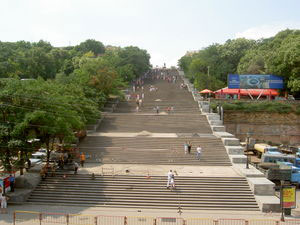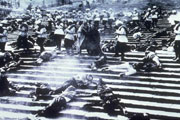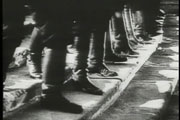
Vol. VII, No. 5, September-October 2007
- Editor's corner
- Embrace eatertainment or clone a dinosaur
- Cyndi Nelson joins White Hutchinson
- Fewer mothers view full-time work as ideal
- Meet Randy White, our CEO, at IAAPA
- Consumers move toward a more sustainable lifestyle
- Foundations Entertainment University announces next seminar
- No more ho-hum food
- There are only five ways to grow your business
- What's happening with uWink?
- "The Girl's Guide to Being a Boss (Without Being a Bitch)"
- New Projects
Editor's corner
It's amazing how much can happen in the three months since we published the last issue of the Leisure eNewsletter. Among other things, I've traveled over 35,000 miles to work on new projects, including trips to Eastern Europe and Nigeria, and to Los Angeles to work with a Korean company.
The Eastern Europe trip gave me the chance to visit Odessa, Ukraine. I was pleasantly surprised by the city. It was nothing like I expected for a former Soviet Union city, but far more like a city in Europe.
The Ukraine is a very young country, gaining independence from the Soviet Union in 1991. Odessa is one of Europe's younger cities, founded by Catherine the Great only a little over 200 years ago in 1794. With an estimated population of 1.1 million, Odessa is the third largest city in the Ukraine and is often referred to as "The Pearl of the Black Sea." Its Black Sea location with its warm water port has given it a very international flavor with a unique blend of Russian, Yiddish and Ukrainian cultures.
Odessa is a highly centralized city, with malls, major stores and most restaurants located in the city's heart. The city is simply enchanting with its marvelous architecture. Odessa's history has left the city with some splendid architecture from the 18th and 19th centuries. A number of buildings were done in Renaissance or Classical styles, which was in favor early this century. Some buildings display a curious mixture of different styles, such as French architecture with a distinct Russian flavor, and some are built in the Art Nouveau Style. Its stately classical architecture is set on orderly planned streets lined with canopies of trees and surrounded with green space, giving the city an air of elegance.
Odessa is a walking city. When I was there during the end of summer, the sidewalks were lined with outdoor cafes where people were socializing and enjoying the weather.
Many buildings fell into disrepair during the Soviet area. However, a growing economy and demand for retail, restaurant and housing space in the central city has produced a major restoration movement, bringing many buildings back to their classic beauty.
While most cities are best known for their statues, towers and buildings, Odessa is best symbolized by the 192 steps, known as the Potemkin Steps (or the Odessa Stairs or Steps), that descend 88.5 feet (27 meters) from Primosky Boulevard to the pier. The stairs were designed by Italian architect Franz Boffo and completed in 1841. The design of the Potemkin Steps creates somewhat of an optical illusion, making the steps seem larger than their actual size. The upper flights are 44.2 feet (13.4 meters) wide while the lower flights are 71.3 feet (21.6 meters) wide. The stairs' name was taken from the battleship Potemkin, immortalized in Russian producer Sergei Eisenstein's 1925 silent film that recounts a heroic tale from the first Russian revolution.

The Potemkin Steps, also known as the Odessa Steps.
The most famous scene in the film, The Battleship Potemkin, depicts the fictional massacre of about 2,000 civilians on the Potemkin Steps. In the scene, the Tsar's Cossacks in their white summer tunics march down a seemingly endless flight of steps in a rhythmic, machine-like fashion, slaughtering the crowd, including a young boy, as people attempt to flee. His mother picks up her son's fallen body and yells at the soldiers to stop firing. Moments later they shoot her. Toward the end of the sequence, the soldiers shoot a mother pushing a baby in a carriage. As she dies, she falls back against the baby carriage, which causes it to roll down the steps amidst the fleeing crowd. Click here to watch a clip of the famous Odessa Staircase scene.
 |
 |
 |
| A wide shot of the massacre on the Potemkin Stairs |
The boots of the Tsarist soldiers shown marching down the Potemkin Stairs |
The baby in the carriage falling down the Potemkin Stairs |
Scenes from the movie, "The Battleship Potemkin." Click to see movie |
||
I can vividly remember the Potemkin Steps scene when I viewed the film during one of my film history classes back in my days (many decades ago) attending the School of Television, Motion Pictures and Radio at New York University. The film is still considered to be one of the greatest action films ever made.
During the end of October I will return to visit other parts of Eastern Europe and Russia. Hopefully I can give that trip some coverage in our next issue.
In this issue of our Leisure eNewsletter, we continue to cover developments in eatertainment and feature what's happening with the new adult restaurant-interactive game concept uWink. We also continue our coverage of the at-home moms' market with research on some mothers' declining interest in full-time work. Green and sustainable are now established trends, but as our story below illustrates, the location-based entertainment industry is slow to catch on. And for anyone interested in basics how-to's for growing a location-based business, don't miss There are only five ways to grow your business. Enjoy.
Randy White
Editor
Vol. VII, No. 5, September-October 2007
- Editor's corner
- Embrace eatertainment or clone a dinosaur
- Cyndi Nelson joins White Hutchinson
- Fewer mothers view full-time work as ideal
- Meet Randy White, our CEO, at IAAPA
- Consumers move toward a more sustainable lifestyle
- Foundations Entertainment University announces next seminar
- No more ho-hum food
- There are only five ways to grow your business
- What's happening with uWink?
- "The Girl's Guide to Being a Boss (Without Being a Bitch)"
- New Projects


